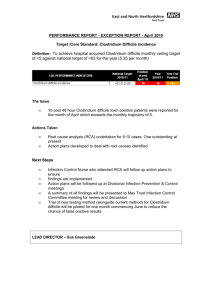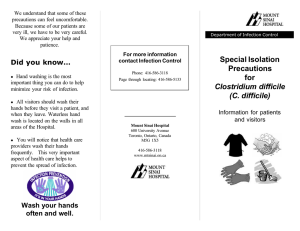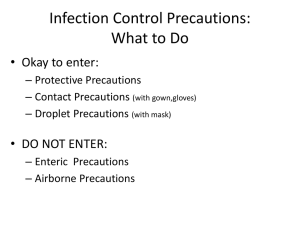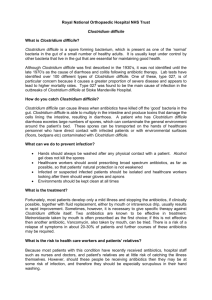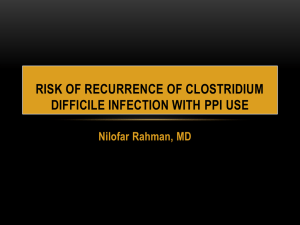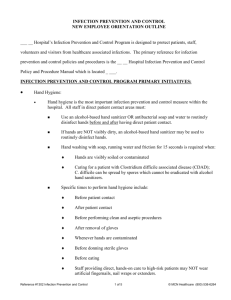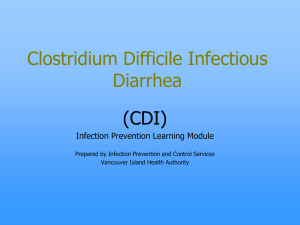Harrington Hospital Clostridium Difficile Policy
advertisement
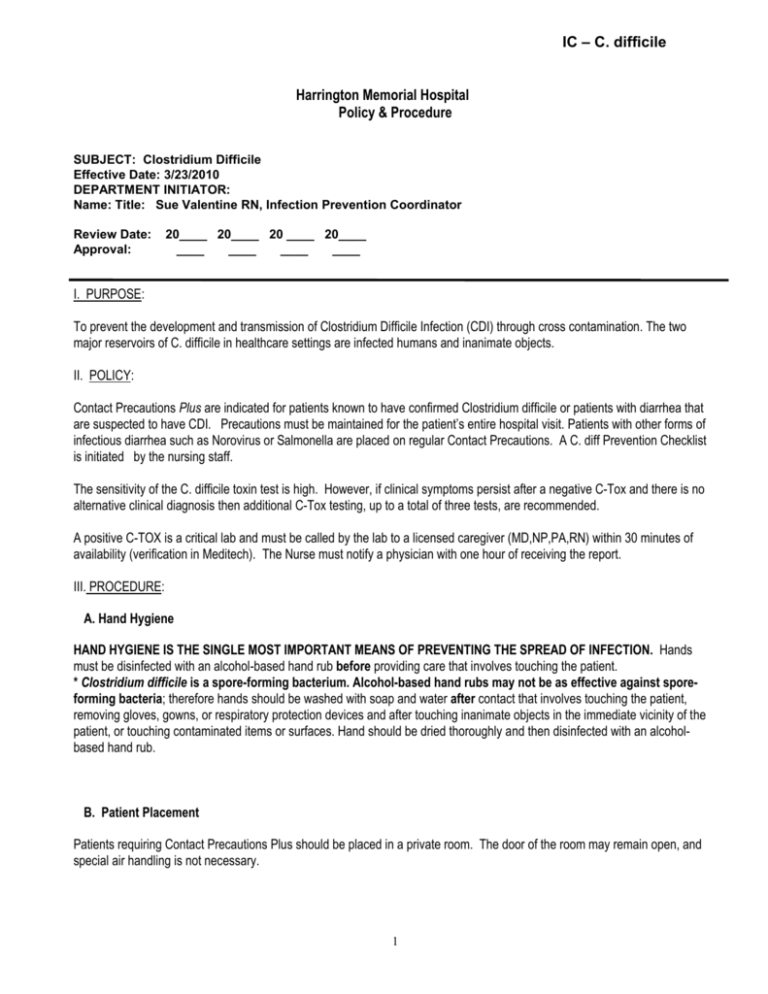
IC – C. difficile Harrington Memorial Hospital Policy & Procedure SUBJECT: Clostridium Difficile Effective Date: 3/23/2010 DEPARTMENT INITIATOR: Name: Title: Sue Valentine RN, Infection Prevention Coordinator Review Date: Approval: 20____ 20____ 20 ____ 20____ ____ ____ ____ ____ I. PURPOSE: To prevent the development and transmission of Clostridium Difficile Infection (CDI) through cross contamination. The two major reservoirs of C. difficile in healthcare settings are infected humans and inanimate objects. II. POLICY: Contact Precautions Plus are indicated for patients known to have confirmed Clostridium difficile or patients with diarrhea that are suspected to have CDI. Precautions must be maintained for the patient’s entire hospital visit. Patients with other forms of infectious diarrhea such as Norovirus or Salmonella are placed on regular Contact Precautions. A C. diff Prevention Checklist is initiated by the nursing staff. The sensitivity of the C. difficile toxin test is high. However, if clinical symptoms persist after a negative C-Tox and there is no alternative clinical diagnosis then additional C-Tox testing, up to a total of three tests, are recommended. A positive C-TOX is a critical lab and must be called by the lab to a licensed caregiver (MD,NP,PA,RN) within 30 minutes of availability (verification in Meditech). The Nurse must notify a physician with one hour of receiving the report. III. PROCEDURE: A. Hand Hygiene HAND HYGIENE IS THE SINGLE MOST IMPORTANT MEANS OF PREVENTING THE SPREAD OF INFECTION. Hands must be disinfected with an alcohol-based hand rub before providing care that involves touching the patient. * Clostridium difficile is a spore-forming bacterium. Alcohol-based hand rubs may not be as effective against sporeforming bacteria; therefore hands should be washed with soap and water after contact that involves touching the patient, removing gloves, gowns, or respiratory protection devices and after touching inanimate objects in the immediate vicinity of the patient, or touching contaminated items or surfaces. Hand should be dried thoroughly and then disinfected with an alcoholbased hand rub. B. Patient Placement Patients requiring Contact Precautions Plus should be placed in a private room. The door of the room may remain open, and special air handling is not necessary. 1 If a private room is unavailable, the patient may be cohorted, i.e., placed in a semi-private room with a patient who is infected with the same organism. If a private room is unavailable and cohorting is not possible, consult with the Infection Prevention Coordinator (ext: 2426) about safe room placement. C. Personal Protective Equipment These precautions apply to all patient care, support staff, and visitors entering the room of a patient on Contact Precautions Plus. A PPE holder with Contact Precaution Plus sign will be placed on patient’s door. House keeping will stock the PPE holder with the bleach–based wipes. 1. Gloves Clean, nonsterile gloves must be worn for entering the room of a patient requiring Contact Precautions Plus. Remove gloves before leaving the room and immediately wash and dry hands.* Clostridium difficile is a spore-forming bacterium. Alcoholbased hand rubs may not be as effective against spore-forming bacteria; therefore hands should be washed with soap and water and then disinfected with an alcohol-based hand rub. . 2. Gowns Clean, disposable isolation gowns must be worn upon entering the room when contact with the patient, with environmental surfaces, or with patient care items is anticipated. Remove the gown before leaving the room and place in a trash bin. Immediately wash and dry hands. D. Patient Care Equipment/Supplies When possible, dedicate the use of equipment (e.g., stethoscope, blood pressure cuff,) to avoid sharing with other patients. Use disposable thermometers. Reusable patient-care equipment in the patient room must be disinfected with a hospital-approved bleach-based germicidal detergent/disinfectant product before use with another patient. Supplies in the room of a patient on Contact Precautions Plus should be kept to a minimum. Unopened sterile supplies and medications can be returned to the appropriate area upon patient discharge. Opened, contaminated, or damaged items must be discarded. E. Patient Transport Notify the Transport Department that the patient is on Contact Precautions Plus and complete the “Ticket to Ride.” The patient should wash his/her hands before leaving the room. The patient should wear a clean cover gown or be covered by a clean sheet or drape for transport to another department or area. The patient’s chart will be transported in a manner that prevents contact with the patient and/or contaminated linen. Gloves and gown should not be worn when transporting the patient through the corridors. All departments receiving the patient will observe contact precautions plus. F. Visitors Visitors should disinfect hands when entering and wash and disinfect when leaving the patient’s room. Visitors need to wear gloves and also a gown if they are coming in contact with the patient or environment. G. Education 2 Patients should be given educational materials that can be shared with family members. This may include but not limited to the HMH fact sheet on Isolation and Precautions and the FAQs (frequently asked questions) about Clostridium Difficile by Shea, IDSA, AHA, APIC, CDC, and JC. H. Room Cleaning Procedures When Contact Precautions Plus are discontinued or when the patient is discharged or transferred use a hospital-approved bleach-based product for cleaning of the patient room paying special attention to all “HIGH-TOUCH” * surfaces. This is a second step in the cleaning process. All toilets and commodes in patient care areas will be cleaned using the bleach wipes. Sanimaster 4 will be used for the preliminary cleaning. The one exception is the floor which will be cleaned with only the Sanimaster 4. *examples of HIGH-TOUCH SURFACES: 1. bedrails 2. mattress 3. head & foot boards 4. bedside table 5. bathroom fixtures 6. commodes 7. pull cords 8. doorknobs 9. call buttons 10. telephones 11. computer key boards 12. all horizontal surfaces H. Specimens Only watery or loose stools should be collected and tested. Swabs are not acceptable. Stool samples must be sent to the lab immediately and stored at 2-8 degrees C until tested. Storage at room temperature decreases the sensitivity of some tests, presumably due to toxin inactivation. References: “Guide to the Elimination of Clostridium difficile in Healthcare Settings”, APIC, 2008 “Clostridium difficile – Associated Disease in the New Millennium”, Owens, Robert and Valenti, Robert. Infectious Diseases in Clinical Practice, Vol 15, Number 5, September 2007. APPROVAL: __________________________________ Ed Moore, President & CEO ____________________________________ M. Gaudet, M.D., Chairperson, Infection Control __________________________________ Sue Valentine RN, Infection Prevention Coordinator Supersedes Policy: None Policy #___________ Date: New 3 4
